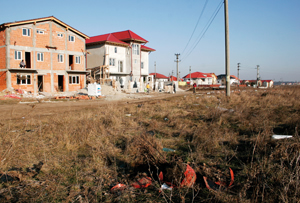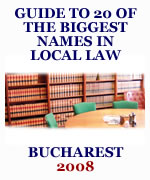Battle for the metropolis
Joined-up development between Bucharest and its surrounding counties is a necessity for the long term health of the capital, its people and investors.
One solution is the Metropolitan Area of Bucharest project.
But many local authorities are against this move, finds Ana Maria Nitoi
 |
|
|||||||||||||
Bucharest is growing at a chaotic rate with an uncoordinated development between the city and county of Ilfov, which is harming the quality of life of the citizens in
Bucharest and undermining long-term investments.
Since 2000, heavy traffic has choked every neighbourhood of Bucharest. That is due to bad metropolitan organisation. The central business district has shifted to the north of the city, while most state institutions are located in the centre. There is a massive exodus to the north from all corners of the city during the morning, and a steady rush towards the centre at all times of the day. Because Bucharest lacks a wide enough ring road to connect the six sectors and suburbs, there are no alternatives to travel other than through the centre. This means four-hour daily commutes, working hours lost and a diminished quality of life and labour.
There are fewer green spaces inside and outside the city because developers in real estate can construct anywhere they like due to the lack of consistent regulation of green spaces and no height restrictions on construction. There is also an absence of public debate on the impact of new developments on their neighbouring areas in and around the city.
Bucharest is also one of the most polluted European capitals, as well as the densest capital in the EU. Pollution is due to the heavy traffic and the few green areas surrounding the city. There is no ‘green belt’ around Bucharest which developers respect.
“We can imagine the toxic gases in the atmosphere, the pollution, as a grey mushroom suspended above the city,” says Mariana Nica, expert at the Centre for Urban and Metropolitan Planning (CPUMP) in the City Hall of Bucharest. “During the day, as everyone goes to the centre, the mushroom comes closer to the earth, but during night this expands to the outskirts of the city and the exchange of dirty air with clean oxygenated air can take place if there are green areas and forests near Bucharest.”
'1') {
require('php/art_auth.inc');
}
?>
City authorities have a strategy for the long term development of Bucharest and the surrounding area to create a so-called Metropolitan Area of Bucharest, drawn up after a study made by experts from CPUMP. Currently there are more than 90 small towns and villages around Bucharest which depend on the capital. Some of these satellite towns rely on the medical care and schools, high schools and universities in Bucharest. In other cases, the capital is the only source for jobs for people leaving near the city. Meanwhile the movement of factories, logistics and warehousing to the outskirts of the city also provides jobs for many in Bucharest.
Creating a Metropolitan Area would mean a single authority which promotes dialogue between the city and surrounding counties to ensure economic development for all the players involved. This authority would be a council made of the mayors of all the towns, villages, as well as the general mayor of Bucharest and the mayors of the six sectors.
“The main objective of such a project would be to bring some order to this mess,” says Florian Velcu, a broker at real estate agency Coldwell Banker.
The legislation needed for this project to be implemented is in force. The existing project provides ideas and investment opportunities, by giving suggestions as to where in this Metropolitan Area it would be best to set up a technological or a logistics park. There is also the need to co-ordinate all the investment plans in the developed areas near Bucharest.
“A conflict can be created and investors could lose money if the capital approves setting up an industrial park on its outskirts, while the neighbouring village allows a real estate developer to build a residential park right next door,” says Florian Velcu.
But setting up the area requires the consensus of all the local authorities. This is the major obstacle.
Many of the mayors of small towns outside the capital understand the plan to be a move to make them bow to the will of Bucharest. “The mayors in most of the towns and villages believe that if this project is put in place they will have to give up their powers and they don’t see it as a partnership,” Nica argues. The Diplomat has tried to contact the mayors of two towns near Bucharest, Otopeni and Popesti Leordeni, but they both refused to talk on this issue.
Many speculators on the real estate market are also against the project. They want to keep the existing set-up which allows them to maximise their land investment by putting up a ten-storey building on the outskirts of Bucharest, in areas dominated by two-storey constructions. The same investors target a fast profit regardless of the consequences for the area. For example, residential developments are now planned inside forests 20 km from Bucharest.
Easier access to EU money
The country’s accession to the EU has brought the opportunity for authorities to spend large amounts of non-reimbursable EU cash. From these, structural funds are destined for large projects, such as the rehabilitation of infrastructure. This money cannot be accessed by a small village, but by an entire area. The Metropolian Area could give the regions involved greater lobbying power to access EU money. It could also speed up the permission for constructions which crossed two districts.
The Metropolitan project also proposes setting up mini-regional areas for development near Bucharest to attract investments. Towns such as Oltenita, Calarasi county, could also develop, creating an area of wealth outside the city.
Another positive consequence would be the rehabilitation of ailing roads. Even the expensive residential area near Bucharest, Baneasa, and the airport town of Otopeni, do not have proper roads, sewerage and water supply. “Not only outside of Bucharest, but also the outskirts of the city have problems with utilities, even with electricity supply,” Florian Velcu, broker at Coldwell Banker, adds
Ten to 20 kilometres from Bucharest lay isolated villages which could be revitalised by constructing accessible roads. This would benefit both Bucharest and the local area. With good infrastructure, investors would be more willing to set up offices or facilities close to these villages. If the people in these villages could also easily access Bucharest, they would have more options in the kind of jobs for which they could apply. If people have more choices in where they can work in their own country, they would be less inclined to find jobs abroad.
At present there are virtually no public transport routes that help the people living in the suburbs of Bucharest to commute to the city for work. Nearly all buses and the metro end at the border of the municipality, while overland short-distance rail is non-existent. There is a “black hole” of empty transport at the borders of Bucharest. Filling this gap are private minivan companies. But these overcharge the travellers and lack proper regulation. In some case the commute to Bucharest is not worth the effort because travel is too expensive.
Make room! Make room!
Bucharest holds more than ten per cent of the country’s population. Officially there are two million people living in the Capital but unofficially it holds between three and 3.5 million inhabitants. In ten years from now, the World Bank predicts an increase of Bucharest’s population to four million inhabitants. Bucharest is by far the most crowded European Capital, shows a statistics drawn up by Coldwell-Banker. The Romanian Capital has an average of 9,079 people per square kilometre, while Paris has only 890 inhabitants per square kilometre, Berlin only 3,905, Vienna 3,850, Rome 2,266 and London only 1,579.
The plan to set up the Metropolitan Area of Bucharest includes a total of nine towns outside Bucharest and hundreds of villages from four counties neighbouring the big city, Ilfov, Calarasi, Ialomita and Giurgiu.
The Metropolitan Area will have 5,046 square kilometres and 2.6 million inhabitants officially.
Currently, Bucharest has 225 square kilometres.
Iasi, Timisoara, Constanta, Targu Mures and Brasov are good examples of metropolitan areas which have been set up because all the mayors in the suburbs of the cities have understood the opportunity for neighbourly development. Oradea’s Metropolitan Area, which is much smaller than the planned dimensions for Bucharest, is the most successful, argues Mihaela Vrabete, general director of Department for Public Strategies and Policies in Ministry of Development, Public Works and Housing.

















